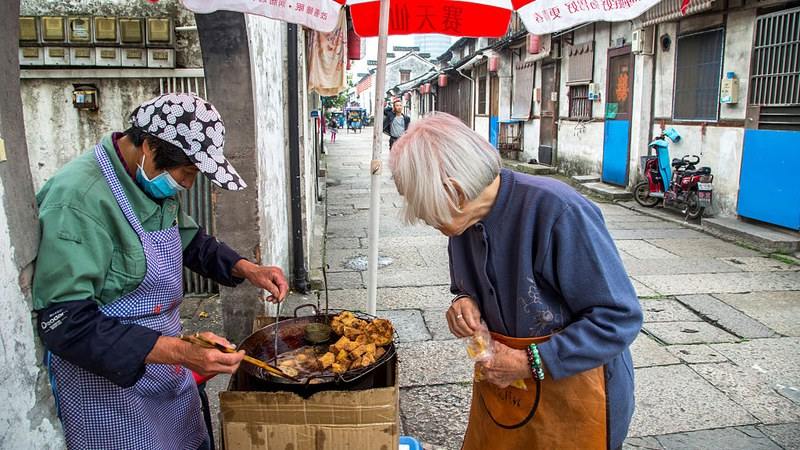Stinky Tofu Is A Celebration Of The Beautiful Stank
In the pantheon of food that smells worse than it tastes, the tradition of stinky tofu (yes, "stinky" is the adjective they went with) is more bark than bite. Found at street stalls and night markets throughout China and Taiwan, stinky tofu is often on the receiving end of hyperbole. I've heard it described as rotting garbage or decaying corpses, which is a colorful description, yes, but not really.
Indeed, it creeps into your sinuses with the pungency of a wet sock, but plenty of foods have that smells bad/tastes great dynamic. Stinky tofu is like Limburger cheese or durian, which is to say, delicious beneath the stink. In fact, most stinky tofu is relatively mild in flavor. It's the smell that gives it a semblance of character—brines vary and can include anything from fermented milk to shrimp—and once you settle into it, it's not that bad. There are variations, of course, with some places priding themselves on stinky tofu so fermented that it looks like a dirty sponge, but it mostly just tastes saltier.
Stinky tofu has been around since the Qing dynasty, with the familiar origin story of accidental discovery. We truly owe a lot to these reckless gastronomers who see or smell something terrible and decide that the best course of action is to eat it.
In Hong Kong, what few food stalls offer stinky tofu serve it up deep-fried. But there's an even more pungent version: steamed stinky tofu. In fact, it's doubly rank, so much so that wet markets have all but stopped serving the dish (a combination of a lack of consumer interest plus concerns about the hygiene of how it's prepared).

I had to look to Taiwan for steamed stinky tofu. (Most stinky tofu aficionados will agree that the Hong Kong version, eaten by Cantonese heathens with hoisin sauce, is inferior to its Taiwanese counterpart.) He Ji, a stinky tofu joint at the bustling Shida night market in Taipei, specializes in a mala stinky tofu hot pot, alongside the more palatable deep-fried stinky tofu. Mala is a Sichuan flavor element: "la" means spicy and "ma" refers to the addictive numbing and tingling sensation caused by Sichuan peppercorns. It's a bit like chewing on Novocaine.
When I ask how it's fermented at He Ji, the otherwise friendly staff clams up. They also won't let me take any pictures of the stinky tofu while it's being cooked, but are fine with pictures of the deadly looking mala broth made with bits of stinky tofu. I decide to keep it classic and order deep-fried stinky tofu instead. I ask my ponytailed waiter whether foreigners ever try the hot pot stinky tofu, and he shakes his head. "It's mostly locals, but I've served it to a few Japanese and Korean tourists. They seemed to enjoy it." I ask him what he thinks of steamed stinky tofu, and he says sheepishly, "I don't eat it. Fried is good enough for me."

When the hot pot set arrives at the next table, I can see (or smell) why. The combination of the mala spiciness and the steamed stinky tofu pungency loosens and kills the hair follicles in my nose. By the time my deep-fried stinky tofu shows up, my dinner companion and I have lapsed into an olfactory coma, so numbed by its intense headiness that we can't even smell it anymore. We mention this to our waiter, who assures us, "This is really smelly, I guarantee it."
It is only after the first bite that the smell fills up my nose. The interesting thing about stinky tofu is that the smell loses its repulsiveness once the tofu is in your mouth. It's like how Parmesan cheese can smell like vomit but once you've started eating it, it's delicious. As another member of the He Ji staff puts it, "The stink is what makes it good if you stop thinking that it smells bad."
The deep-fried tofu at He Ji has a light, crispy skin over a soft, slightly crumbly interior and comes with a light, salty-sweet sauce and pickled vegetables whose sourness feels like an elaboration on the fermented taste of the stinky tofu. It's not the stinkiest tofu I've had, but it's definitely much, much better than the tough slabs of stinky tofu you get at Hong Kong street-food stalls. In Taipei, you can also get barbecued stinky tofu slathered with condiments—sweet pickled vegetables, funky chili sauces, bamboo shoots—but all of the extra accouterments diminish the best part about it: the stink, at which point it's just eating regular tofu, and where's the novelty in that?
I ask our waiter: Why do Taiwanese people like stinky tofu so much? He is puzzled at the idea that it's something particular to Taiwan but concludes, "It's probably because we grew up with it and are used to it." Perhaps he's right. One of the souvenirs of a trip to a stinky tofu purveyor is the smell that embeds itself into your hair and clothing and lingers long after. "You ate stinky tofu?" the driver asks us when we board a bus after our meal. For a second, the "No durians" sign in the Singapore metro flashes through my mind, and I think that he's going to ask us to get off. But all he says is, "I know a great place that you can try next time."
